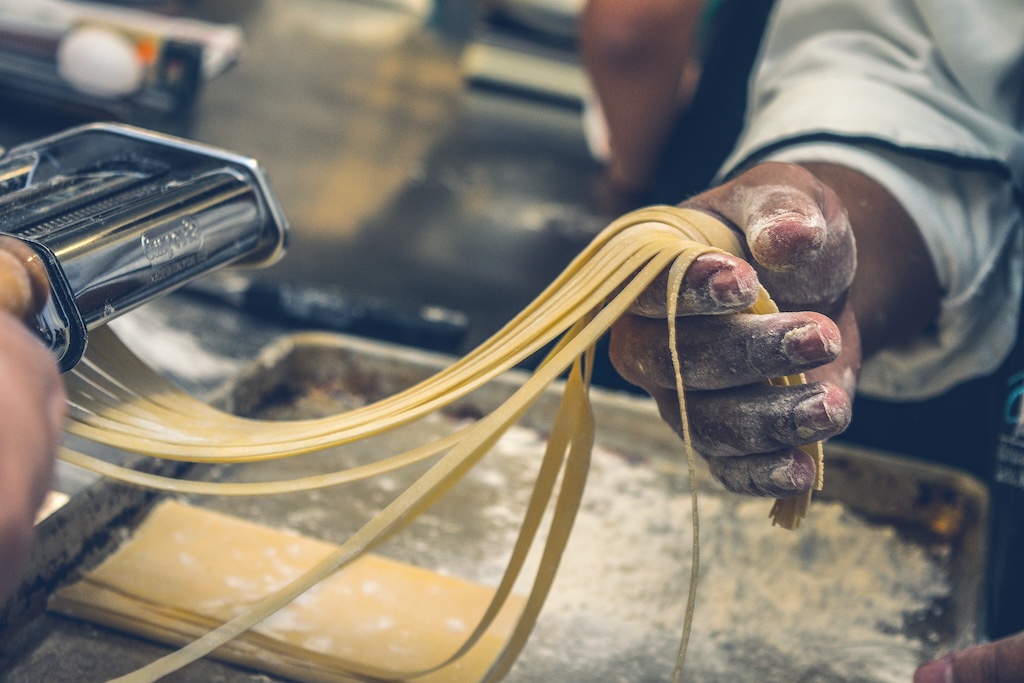What to Eat in Italy During the Jubilee 2025

Italian cuisine is one of the most beloved culinary traditions worldwide. With its rich history, diverse regional flavors, and a focus on fresh, high-quality ingredients, Italian food has captured the hearts (and stomachs) of people everywhere.
If you are going to be in Italy in 2025 for Jubilee, read this guide to learn what to expect from one of the best cuisines in the world. Whether you’re a seasoned foodie or just beginning your culinary journey, this guide will walk you through the must-try dishes of Italian cuisine.
The History of Italian Cuisine
Origins
Italian cuisine has its roots in ancient Roman times, with influences from Greek, Arabic, and even Norman cultures. The Romans were known for their elaborate feasts, which included a variety of meats, vegetables, and fruits. Over time, Italian cooking evolved, absorbing the flavors and techniques of different civilizations that came to the Italian peninsula.
Influence of Different Cultures on Italian Food
The fall of the Roman Empire and subsequent invasions by different cultures brought new ingredients and cooking methods to Italy. For example, the introduction of rice by the Arabs led to the development of risotto, while Norman rule in Sicily introduced the concept of frying foods. Each region in Italy developed its own unique culinary identity, influenced by the local ingredients and the cultures that settled there.
Evolution of Italian Dishes Over Time
Italian cuisine has continually evolved over the centuries, yet it has always maintained a strong emphasis on simplicity and quality. Traditional recipes have been passed down through generations, with each family adding their own twist. Today, Italian food is a harmonious blend of old-world recipes and modern techniques.
Key Ingredients in Italian Cuisine
Olive Oil
Olive oil is a staple in Italian cooking, often referred to as “liquid gold.” It’s used in almost every dish, from salads to main courses and even desserts. The quality of olive oil can significantly affect the flavor of a dish, with extra virgin olive oil being the most prized for its rich taste and health benefits.
Fresh Herbs and Spices
Italian cuisine relies heavily on fresh herbs and spices to enhance the natural flavors of the ingredients. Basil, oregano, rosemary, and thyme are commonly used in a variety of dishes, adding depth and aroma. Garlic, another key ingredient, is often sautéed in olive oil to create a flavorful base for sauces and soups.
Italian Cheeses: Parmesan, Mozzarella, and More
Italian cheeses are world-renowned, with Parmesan and Mozzarella being two of the most famous. Parmesan, known for its sharp and nutty flavor, is often grated over pasta and salads. Mozzarella, with its creamy texture, is a key ingredient in dishes like Caprese salad and pizza. Other notable cheeses include Gorgonzola, Pecorino, and Ricotta.
Pasta and its Varieties
Pasta is synonymous with Italian cuisine, and there are countless varieties to explore. From long strands like spaghetti and fettuccine to short shapes like penne and rigatoni, pasta is a versatile ingredient that can be paired with a wide range of sauces. Fresh pasta, made from eggs and flour, is often used in more delicate dishes like ravioli and tortellini.
Must-Try Italian Dishes
Classic Italian Appetizers
Bruschetta
A simple yet delicious starter, bruschetta consists of grilled bread rubbed with garlic and topped with fresh tomatoes, basil, and a drizzle of olive oil. It’s a perfect example of how Italian cuisine turns simple ingredients into something extraordinary.
Caprese Salad
Another classic appetizer, Caprese salad is a celebration of fresh ingredients. Slices of ripe tomatoes, creamy mozzarella, and fragrant basil are drizzled with olive oil and balsamic vinegar.
Iconic Italian Pasta Dishes
Spaghetti Carbonara
Spaghetti Carbonara is a rich and indulgent pasta dish made with eggs, pancetta, Parmesan cheese, and black pepper. The creamy sauce is created by tossing the hot pasta with the egg mixture, resulting in a dish that’s both comforting and satisfying.
Lasagna
Lasagna is a hearty baked pasta dish that layers sheets of pasta with a rich meat sauce, creamy béchamel, and plenty of cheese. It’s a labor of love, but the result is a comforting and flavorful meal that’s perfect for sharing with family and friends.
Popular Italian Main Courses
Osso Buco
Osso Buco, which means “bone with a hole,” is a traditional Milanese dish made with braised veal shanks. The meat is slow-cooked in a rich sauce of white wine, broth, and vegetables until it’s tender and flavorful. It’s often served with risotto or polenta.
Chicken Parmigiana
Chicken Parmigiana, or Chicken Parmesan, is a beloved Italian-American dish that features breaded and fried chicken cutlets topped with marinara sauce and melted mozzarella cheese. It’s typically served with a side of pasta or a salad.
Delicious Italian Pizzas
Margherita Pizza
Margherita pizza is a simple yet iconic pizza that features a thin crust topped with tomato sauce, fresh mozzarella, and basil. The colors of the ingredients—red, white, and green—are said to represent the Italian flag.
Quattro Stagioni
Quattro Stagioni, or “Four Seasons,” is a pizza that divides the toppings into four sections, each representing a different season. Common toppings include artichokes, ham, mushrooms, and olives, offering a variety of flavors in one pizza.
Irresistible Italian Desserts
Tiramisu
Tiramisu is a classic Italian dessert made with layers of coffee-soaked ladyfingers, mascarpone cheese, and cocoa powder. It’s light, creamy, and slightly sweet, with a hint of bitterness from the coffee, making it the perfect end to a meal.
Cannoli
Cannoli are crispy pastry tubes filled with a sweet ricotta filling, often studded with chocolate chips or candied fruit. Originating from Sicily, cannoli are a delightful treat that combines crunchy and creamy textures in every bite.
Regional Specialties Across Italy
Northern Italy
Risotto
Risotto is a creamy rice dish that’s a staple in Northern Italy. Made with Arborio rice, which has a high starch content, risotto is cooked slowly with broth until it reaches a rich, velvety consistency. It’s often flavored with ingredients like saffron, mushrooms, or seafood.
Polenta
Polenta is a traditional dish made from cornmeal that’s cooked slowly until it becomes a smooth, porridge-like consistency. It can be served creamy or allowed to cool, then sliced and grilled. Polenta is often paired with hearty meats or stews.
Central Italy
Porchetta
Porchetta is a savory, boneless pork roast that’s seasoned with garlic, rosemary, and other herbs, then slow-cooked until the skin is crispy and the meat is tender. It’s a popular street food in Central Italy, often served in a sandwich.
Ribollita
Ribollita is a hearty Tuscan soup made with leftover bread, beans, and vegetables. The name “ribollita” means “reboiled,” as the soup is traditionally made by reheating leftovers. It’s a comforting dish that’s perfect for chilly days.
Southern Italy
Arancini
Arancini are deep-fried rice balls filled with ingredients like ragù, mozzarella, and peas. Originating from Sicily, these golden, crispy treats are a popular street food throughout Southern Italy.
Orecchiette with Broccoli Rabe
Orecchiette, which means “little ears,” is a type of pasta that’s popular in Southern Italy. It’s often served with broccoli rabe, garlic, and chili flakes, creating a simple yet flavorful dish that’s both hearty and satisfying.
Pairing Italian Food with Wine
Wine Regions in Italy
Italy is home to some of the world’s most renowned wine regions, including Tuscany, Piedmont, and Veneto. Each region produces wines that are as diverse as the food, from bold reds to crisp whites.
Red Wines to Try
Italian red wines are known for their depth and complexity. Chianti, from Tuscany, is a classic choice that pairs well with pasta dishes and red meats. Barolo, from Piedmont, is a robust wine with rich flavors of dark fruit and spices, making it an excellent match for hearty stews and roasts.
White Wines to Try
Italian white wines are typically light and refreshing, perfect for pairing with seafood and lighter dishes. Pinot Grigio, from the Veneto region, is a popular choice with its crisp and fruity flavor. Vermentino, from Sardinia, offers a more complex profile with notes of citrus and herbs.
Tips for Enjoying Authentic Italian Cuisine
Dining Etiquette in Italy
When dining in Italy, it’s important to embrace the local customs. Meals are meant to be enjoyed slowly, with plenty of time to savor each course. Italians typically start with an antipasto, followed by a primo (pasta or soup), secondo (meat or fish), and finally dolce (dessert). Coffee is usually served after dessert, not with it.
How to Spot Authentic Italian Restaurants
Authentic Italian restaurants often have a few telltale signs. Look for a menu that focuses on seasonal ingredients and traditional recipes. The best places are often family-run and have a warm, welcoming atmosphere. Avoid places that have overly extensive menus or use touristy gimmicks to lure in customers.
Buon appetito!
Italian cuisine offers a world of flavors to explore, from simple yet exquisite appetizers to rich and comforting main courses and desserts. Whether you’re indulging in a classic dish like spaghetti carbonara or trying a regional specialty like arancini, there’s always something new and delicious to discover in Italian food.
So go ahead, grab a fork, and remember that one of the best Jubilee 2025 souvenirs can start with your culinary journey through Italy!
